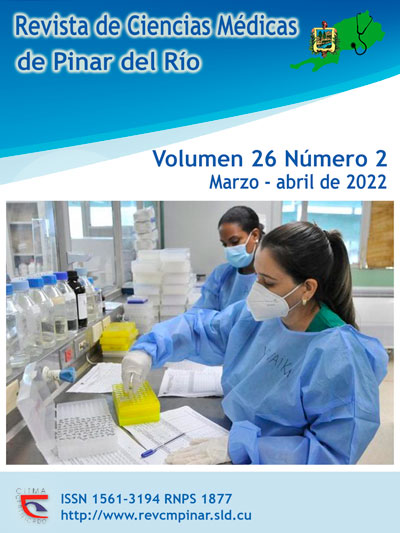Neuralgia del nervio intermediario por dolicoectasia vertebrobasilar
Palabras clave:
NEURALGIA, CEFALEA.Resumen
Introducción: el nervio intermediario constituye la raíz sensitiva del nervio facial y fue descrito por Wrisberg en 1777 como un ramo separado. Dentro de sus funciones se encuentra el control de secreción salival y lacrimal, función gustativa y sensibilidad cutánea de partes del oído externo. La dolicoectasia vertebrobasilar se caracteriza por un complejo vertebrobasilar dilatado, elongado y tortuoso.
Presentación de caso: paciente con cefalea de dos meses de evolución, referida a la región del pabellón auricular y conducto auditivo externo izquierdos, de comienzo súbito, duración menor de un minuto, de carácter eléctrico y severa intensidad según escala visual análoga. Se sospechó neuralgia del nervio intermediario izquierdo. Se realizó una tomografía multicorte de cráneo-encéfalo y resonancia magnética de cráneo-encéfalo con técnica de angiografía. No se evidenció lesión ocupativa de espacio intracraneal ni en conducto auditivo. Se evidenció complejo vertebrobasilar elongado y distendido, se diagnosticó dolicoectasia vertebrobasilar. Se instauró tratamiento con carbamazepina 600mg diario con lo cual existió resolución total de las crisis dolorosas.
Conclusiones: la neuralgia del intermediario debe considerarse como diagnóstico diferencial en pacientes con dolor de carácter neuropático referido a la región del conducto auditivo externo. La dolicoectasia vertebrobasilar se identificó como la causa de la compresión neural. El tratamiento farmacológico constituye la primera línea de tratamiento para estos pacientes.
Descargas
Citas
1. Ching AL, Rosenfeld JV, Di Ieva A. Cranial Nerve Nomenclature: Historical Vignette. World Neurosurg [Internet]. 2019 [Citado 05/09/2021]; 128: 299-307. Disponible en: https://doi.org/10.1016/j.wneu.2019.05.036
2. Bunch PM. Anatomic Eponyms in Neuroradiology: Head and Neck. Academic Radiology [Internet]. 2016 [Citado 05/09/2021]; 23(10): 1319–1332. Disponible en: http://dx.doi.org/10.1016/j.acra.2016.04.011
3. Tubbs RS, Steck DT, Mortazavi MM, Cohen-Gadol AA. The Nervus Intermedius: A Review of Its Anatomy, Function, Pathology, and Role in Neurosurgery. World Neurosurg [Internet]. 2013 [Citado 05/09/2021]; 79(5/6): 763-767. Disponible en: http://dx.doi.org/10.1016/j.wneu.2012.03.023
4. Porras-Gallo MI, Peña-Melian A, Viejo F, Hernández T, Puelles E, Echevarría D, et al. Overview of the History of the Cranial Nerves: From Galen to the 21st Century. The Anatomical Record [Internet]. 2019 [Citado 05/09/2021]; 302(3): 381–393. Disponible en: http://dx.doi.org/ 10.1002/ar.23928
5. Peris-Celda M, Oushy S, Perry A, Graffeo ChS, Carlstrom LP, Zimmerman RS, et al. Nervus intermedius and the surgical management of geniculate neuralgia. J Neurosurg [Internet]. 2019 [Citado 05/09/2021]; 131(2): 343–351. Disponible en: https://thejns.org/doi/abs/10.3171/2018.3.JNS172920
6. Prasad SN, Singh V, Selvamurugan V, Phadke RV. Vertebrobasilar dolichoectasia with typical radiological features. BMJ Case Rep [Internet]. 2021 [Citado 05/09/2021]; 14(2): e239866. Disponible en: http://dx.doi.org/10.1136/bcr-2020-239866
7. Chen Z, Zhang S, Dai Z, Cheng X, Wu M, Dai Q. Recurrent risk of ischemic stroke due to Vertebrobasilar Dolichoectasia. BMC Neurol [Internet]. 2019 [Citado 05/09/2021]; 19(163). Disponible en: https://doi.org/10.1186/s12883-019-1400-9
8. Elakkad SE, Yetto JM, Landon MD, Cathey MR. Stuck in the Middle: Nervus Intermedius–Related Neuropathologic Imaging Spectrum. Neurographics [Internet]. 2019 [Citado 05/09/2021]; 9(5): 330–343. Disponible en: http://dx.doi.org/10.3174/ng.1900006
9. Olesen J, Ducros A, Dodick DW, First MB. The International Classification of Headache Disorders, 3rd edition (ICHD-3). ResearchGate. Cephalalgia [Internet]. 2018 [Citado 05/09/2021]; 38(1): 1-121. Disponible en: http://dx.doi.org/10.1177/0333102417738202
10. Inoue T, Shima A, Hirai H, Suzuki F, Matsuda M. Nervus Intermedius Neuralgia Treated with Microvascular Decompression: A Case Report and Review of the Literature. NMC Case Report Journal Adv Pub [Internet]. 2016 [Citado 05/09/2021]; 4(3): 75-78. Disponible en: http://dx.doi.org/10.2176/nmccrj.cr.2016-0261
11. Homeida L, Elmuradi S, Sollecito TP, Stoopler ET. Synchronous presentation of trigeminal, glossopharyngeal and geniculate neuralgias in a single patient. Oral Medicine [Internet]. 2016 [Citado 05/09/2021]; 121(6): 626-628. Disponible en: http://dx.doi.org/10.1016/j.oooo.2016.02.007
12. Grin EJ, Grin P. Nervus intermedius neuralgia in a ten-year-old boy. International Journal of Medical Reviews and Case Reports [Internet]. 2020 [Citado 05/09/2021]; 4(11): 22-25. Disponible en: http://dx.doi.org/10.5455/IJMRCR.Nervus-Intermedius-Neuralgia
13. Huamán L, Soto P, Yaya H. Neuralgia del Trigémino por Dolicoectasia Vertebro Basilar, Reporte de Caso. Revista Médica Carriónica [Internet]. 2017 [Citado 05/09/2021]; 4(4): 39. Disponible en: http://cuerpomedico.hdosdemayo.gob.pe/index.php/revistamedicacarrionica/article/view/213
14. López-Zuazo I, Sánchez MJ, Salinas MA. Dolor facial. Medicine [Internet]. 2015 [Citado 05/09/2021]; 11(70): 4184-97. Disponible en: https://www.clinicalkey.es/#!/content/journal/1-s2.0-S0304541215708966
15. Tubbs RS, Mosier KM, Cohen-Gadol AA. Geniculate Neuralgia: Clinical, Radiologic, and Intraoperative Correlates. World Neurosurg [Internet]. 2013 [Citado 05/09/2021]; 80(6): 353-7. Disponible en: http://dx.doi.org/10.1016/j.wneu.2012.11.053
Publicado
Cómo citar
Número
Sección
Licencia
Aquellos autores/as que tengan publicaciones con esta revista, aceptan los términos siguientes:- Los autores/as conservarán sus derechos de autor y garantizarán a la revista el derecho de primera publicación de su obra, el cuál estará simultáneamente sujeto a la Licencia de reconocimiento de Creative Commons que permite a terceros compartir la obra siempre que se indique su autor y su primera publicación esta revista.
- Los autores/as podrán adoptar otros acuerdos de licencia no exclusiva de distribución de la versión de la obra publicada (p. ej.: depositarla en un archivo telemático institucional o publicarla en un volumen monográfico) siempre que se indique la publicación inicial en esta revista.
- Se permite y recomienda a los autores/as difundir su obra a través de Internet (p. ej.: en archivos telemáticos institucionales o en su página web) antes y durante el proceso de envío, lo cual puede producir intercambios interesantes y aumentar las citas de la obra publicada. (Véase El efecto del acceso abierto).



